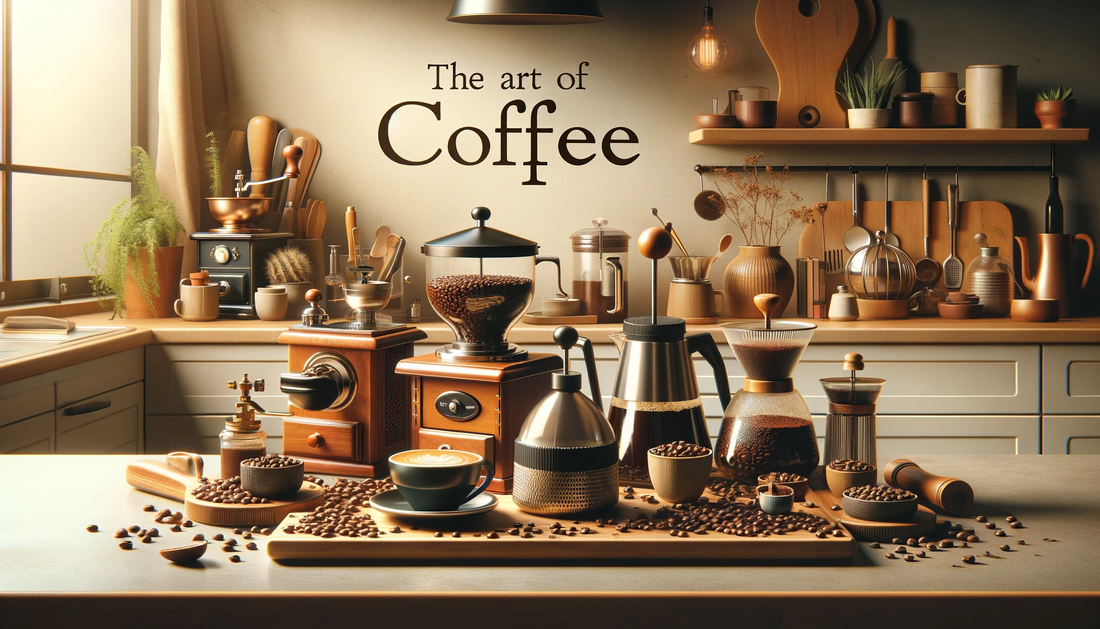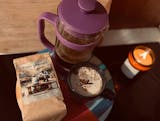Are you tired of mediocre coffee that fails to awaken your senses? If so, it's time to take your home brewing game to the next level. In this article, we will explore the art of coffee and show you how to elevate your cup of joe with the right coffee supplies and equipment. Whether you're a coffee connoisseur or simply a lover of a good brew, this guide will help you unlock the full potential of your daily dose of caffeine.
From selecting the perfect beans to brewing methods and equipment, we'll cover it all. Discover the secrets to achieving a rich and flavorful coffee at home, just like your favorite barista. We will explore the different types of coffee makers, grinders, and other supplies that can enhance your coffee experience. Say goodbye to generic, lackluster cups of joe and say hello to a higher level of brewing excellence.
Join us on this journey as we unveil the art of coffee and equip you with the knowledge and tools to become a true coffee aficionado. Get ready to awaken your taste buds and embark on a coffee adventure like no other.
The first step to elevating your home brewing game is understanding the importance of using the right coffee supplies and equipment. While it may be tempting to settle for instant coffee or pre-ground beans, investing in quality supplies can make a world of difference in the taste and aroma of your brew.
When it comes to coffee supplies, one of the most crucial elements is the coffee beans themselves. Opt for freshly roasted beans that are within two weeks of their roast date. Look for beans that are sourced from reputable coffee farms and offer a variety of flavor profiles. Experiment with different origins and roast levels to find your preferred taste.
In addition to the beans, a good grinder is essential for achieving consistent grind sizes. Invest in a burr grinder, as it ensures a uniform grind and allows for better extraction during brewing. Avoid blade grinders, as they tend to produce uneven particles, which can result in over-extraction or under-extraction.
Another important coffee supply is a digital scale. Measuring your coffee and water using precise ratios is key to achieving a balanced and flavorful brew. A scale allows you to accurately measure the coffee-to-water ratio, ensuring consistency in each cup.
Lastly, a gooseneck kettle is a valuable tool for controlling the water flow during the brewing process. This type of kettle allows for precise pouring, which is especially important in pour-over and French press brewing methods. It helps maintain a steady water temperature and promotes an even extraction.
By investing in quality coffee supplies such as fresh beans, a burr grinder, a digital scale, and a gooseneck kettle, you'll be well on your way to brewing exceptional coffee at home.
Now that you understand the importance of using the right coffee supplies, let's dive into the various brewing methods that can elevate your coffee experience. Each method offers a unique flavor profile and allows you to customize your brew to suit your taste preferences.
1. Drip Coffee
Drip coffee is one of the most common brewing methods, often associated with traditional coffee makers. It involves pouring hot water over coffee grounds, which then passes through a filter and drips into a carafe below. This method is known for producing a clean and balanced cup of coffee, with a medium body and moderate acidity.
To brew drip coffee, start by grinding your coffee beans to a medium-coarse consistency. This ensures optimal extraction without over-extraction. Place the coffee grounds in the filter basket, add water to the reservoir, and let the machine do its magic. Enjoy a classic cup of drip coffee any time of the day.
2. French Press
The French press brewing method is renowned for its full-bodied and rich flavor. It involves steeping coffee grounds in hot water and then pressing a plunger to separate the grounds from the liquid. This method allows for a longer contact time between the water and coffee, resulting in a stronger and more robust brew.
To brew coffee using a French press, start by coarsely grinding your coffee beans. Add the grounds to the French press carafe, pour hot water over them, and let them steep for about four minutes. Slowly press the plunger down to separate the grounds from the coffee. Pour into your favorite mug and savor the bold flavors of a French press brew.
3. Pour-over
Pour-over brewing is a method that involves manually pouring hot water over coffee grounds in a slow and controlled manner. This method allows for precise control over the brewing process, resulting in a clean and nuanced cup of coffee. It highlights the flavors and characteristics of the coffee beans without overpowering them.
To brew coffee using a pour-over method, you'll need a pour-over cone (such as a V60 or Chemex), a paper filter, and a kettle with a gooseneck spout. Start by placing the filter in the cone and rinsing it with hot water to remove any paper taste. Add the coffee grounds to the filter, pour a small amount of water to bloom the coffee, and then gradually pour the remaining water in a circular motion. Enjoy the delicate flavors of a well-crafted pour-over coffee.
4. Espresso
Espresso is a concentrated form of coffee that is brewed by forcing pressurized hot water through finely ground coffee. This brewing method produces a strong and intense flavor, with a thick layer of crema on top. Espresso is the foundation of many popular coffee drinks, such as cappuccinos and lattes.
To brew espresso at home, you'll need an espresso machine. Start by grinding your coffee beans to a fine consistency. Pack the grounds into the portafilter and lock it into the machine. Allow the machine to heat up, then start the extraction process. The water should pass through the coffee grounds at a consistent rate, resulting in a rich and flavorful shot of espresso. Experiment with different coffee beans and extraction times to find your perfect espresso.
When it comes to brewing coffee at home, having the right equipment can make all the difference in the world. Here, we'll explore different types of coffee equipment, each offering a unique brewing experience.
1. Coffee Maker
A coffee maker is a popular choice for many coffee lovers due to its convenience and ease of use. There are various types of coffee makers available, ranging from basic drip brewers to more advanced models with programmable features. When selecting a coffee maker, consider factors such as brew size, brewing time, and additional features like built-in grinders or thermal carafes.
2. French Press
A French press is a classic and straightforward way to brew coffee. It consists of a glass or stainless steel carafe with a plunger and a mesh filter. French press brewing allows for a longer contact time between water and coffee, resulting in a bold and rich flavor. It's an excellent choice for those who prefer a full-bodied cup of coffee.
3. Pour-over Cone
For those who enjoy a more hands-on brewing experience, a pour-over cone is an excellent choice. It allows for precise control over the brewing process, resulting in a clean and nuanced cup of coffee. Popular pour-over cones include the V60 and Chemex. These cones require paper filters and a kettle with a gooseneck spout for optimal pour control.
4. Espresso Machine
If you're a fan of espresso-based drinks like cappuccinos and lattes, investing in an espresso machine is a game-changer. Espresso machines use pressurized water to extract coffee, resulting in a concentrated and intense flavor. There are various types of espresso machines available, ranging from manual lever machines to fully automatic models. Consider factors such as budget, ease of use, and desired level of control when selecting an espresso machine.
Choosing the right coffee equipment depends on your brewing preferences, level of involvement, and budget. It's essential to consider factors such as convenience, flavor profile, and the brewing experience you desire.
To truly appreciate the art of coffee, it's essential to understand the different aspects of coffee beans. From the types of beans to roast levels and origins, each element contributes to the flavor and characteristics of your brew.
1. Types of Coffee Beans
The two main types of coffee beans are Arabica and Robusta. Arabica beans are known for their high-quality flavor and aroma, making up the majority of specialty coffee. They have a wide range of flavor profiles, ranging from fruity and floral to chocolatey and nutty. Robusta beans, on the other hand, are generally stronger and more bitter in taste. They contain a higher caffeine content and are often used in blends or for espresso.
2. Roast Levels
Coffee beans are typically roasted to different levels, each resulting in distinct flavors and characteristics. The three main roast levels are light, medium, and dark.
- Light roast: Light roast beans are roasted for a shorter time, allowing the natural flavors of the coffee to shine. They generally have a bright acidity, floral notes, and a lighter body.
- Medium roast: Medium roast beans strike a balance between acidity and richness. They have a more rounded flavor profile with notes of chocolate, caramel, and nuts.
- Dark roast: Dark roast beans are roasted for a longer time, resulting in a bolder and more robust flavor. They often have smoky, earthy notes and a heavier body.
3. Origins
Coffee beans are grown in various regions around the world, each with its unique flavor characteristics. Some popular coffee origins include Ethiopia, Colombia, Brazil, Guatemala, and Kenya. These origins offer different flavor profiles based on factors such as climate, altitude, soil composition, and processing methods. Exploring beans from different origins allows you to discover new flavors and expand your coffee palate.
Understanding the types of coffee beans, roast levels, and origins allows you to make informed decisions when selecting beans for your brew. Experiment with different combinations to find your preferred flavor profile and embark on a journey of coffee exploration.
The grind size of your coffee beans plays a crucial role in the extraction process, as it determines the surface area exposed to water. Different brewing methods require specific grind sizes to achieve optimal flavor extraction. Let's explore the grind sizes for various brewing methods.
1. Coarse Grind
Coarse grind is typically used for brewing methods that involve longer steeping times, such as French press and cold brew. The larger particles allow for a slower extraction, resulting in a full-bodied and less acidic cup of coffee. A coarse grind resembles rough sea salt or breadcrumbs.
2. Medium Grind
Medium grind is versatile and suitable for a wide range of brewing methods, including drip coffee makers, pour-over cones, and Aeropress. It offers a balanced extraction, capturing the desired flavors without over-extracting or under-extracting. A medium grind resembles granulated sugar or sand.
3. Fine Grind
Fine grind is used for brewing methods with shorter contact times, such as espresso and Moka pot. The smaller particles allow for a quick extraction, resulting in a concentrated and intense flavor. A fine grind resembles powdered sugar or flour.
It's important to note that consistency is key when it comes to grind size. Uneven particles can lead to inconsistent extraction, resulting in a brew with uneven flavor profiles. Invest in a quality burr grinder to ensure a uniform grind size and enhance the overall quality of your coffee.
The quality of water used for brewing coffee can greatly impact the taste and aroma of the final cup. It's important to consider both water quality and temperature to achieve optimal coffee extraction.
1. Water Quality
Using filtered or bottled water is recommended for brewing coffee, as tap water may contain impurities or mineral content that can alter the taste. Chlorine, for example, can result in a harsh or chemical taste. Filtered water helps ensure a clean and pure flavor, allowing the coffee's natural characteristics to shine through.
2. Water Temperature
Water temperature also plays a crucial role in coffee extraction. The ideal temperature range for brewing coffee is between 195°F and 205°F (90°C and 96°C). Water that is too hot can lead to over-extraction, resulting in a bitter and unpleasant taste. On the other hand, water that is too cold may not extract enough flavor from the coffee grounds, resulting in a weak and
When it comes to brewing the perfect cup of coffee, one often overlooked factor is the quality of water used. Water makes up the majority of your coffee, so it's crucial to use the best possible water. The ideal water should be free from impurities and have a neutral pH level. Hard water, which contains high levels of minerals, can hinder the extraction process and result in a lackluster brew.
To ensure the best water quality, consider investing in a water filter or using bottled spring water. Filtering your water can remove any contaminants that may affect the taste of your coffee. Additionally, be mindful of the water temperature. The ideal range for brewing coffee is between 195°F and 205°F. Too hot, and you risk over-extraction, leading to a bitter taste. Too cold, and the flavors won't fully develop.
Now that we've covered the importance of water quality, let's dive into some tips for brewing the perfect cup of coffee at home. The key to a great brew lies in finding the right balance between the coffee beans, grinding, and brewing method. Here are some essential tips to help you on your journey to coffee perfection:
1. Choosing the right beans: Start by selecting high-quality coffee beans that suit your taste preferences. Consider factors such as the roast level, origin, and flavor notes. Experiment with different varieties to find your perfect match.
2. Grinding your beans: Invest in a good coffee grinder to ensure consistent particle size. For most brewing methods, a medium grind is ideal. Adjust the grind size according to your brewing method. Remember, freshly ground coffee is always superior in taste compared to pre-ground coffee.
3. Brewing methods: There are various brewing methods to choose from, each with its unique characteristics. Some popular options include pour-over, French press, AeroPress, and espresso machines. Experiment with different methods to find the one that suits your preferences.
4. Brewing ratios and techniques: Pay attention to the coffee-to-water ratio. The standard ratio is 1:16 (1 gram of coffee for every 16 grams of water), but this can be adjusted to taste. Additionally, explore different brewing techniques, such as bloom, agitation, and steeping times, to further enhance the flavors.
5. Time and patience: Brewing a great cup of coffee takes time and patience. Allow the coffee to bloom and extract fully before pouring. Rushing the process can result in an under-extracted brew with weak flavors.
By following these tips, you'll be well on your way to brewing a cup of coffee that rivals your favorite café.


